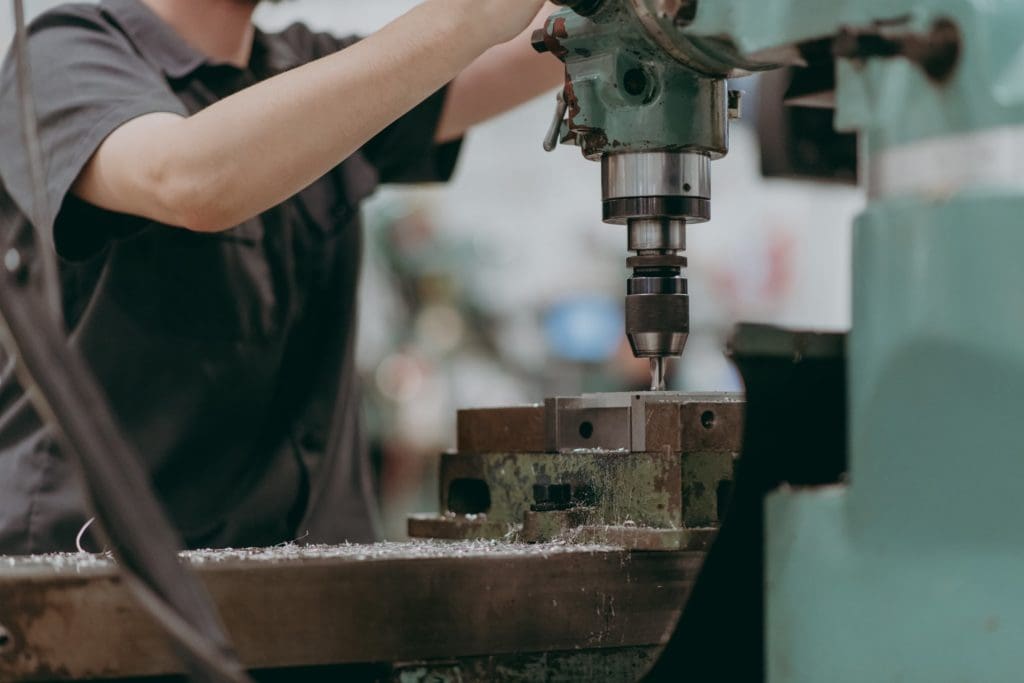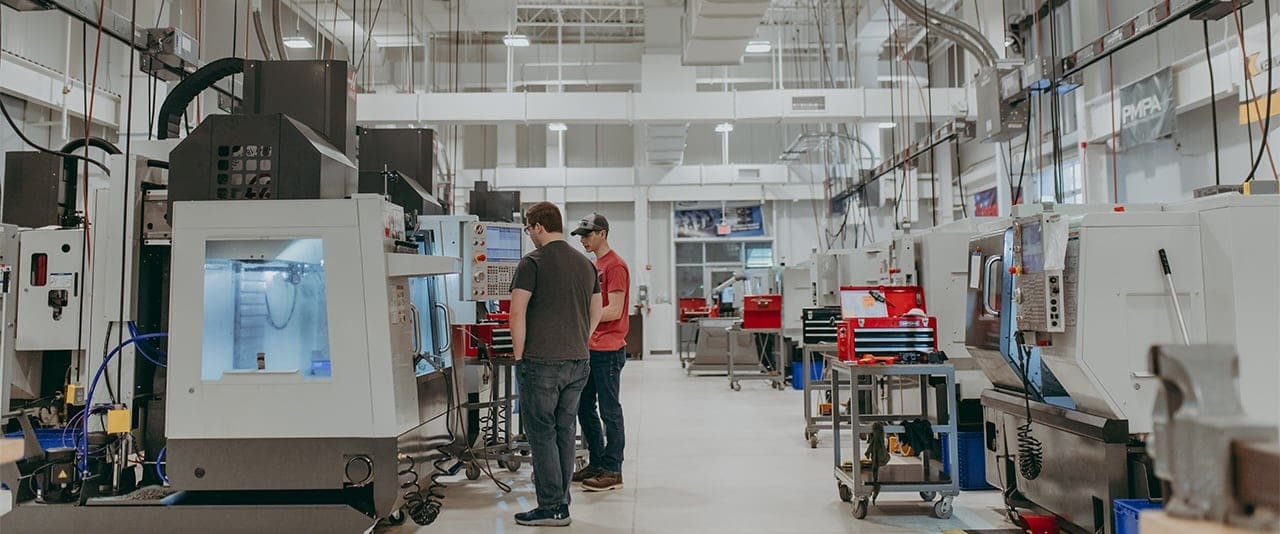
Computer Integrated Machining
Get started today
About Computer Integrated Machining
Students in the Computer Integrated Machining program will spend considerable time in the study and actual operation of industrial equipment and tools to develop skills used by tool and die making companies and production and manufacturing facilities. This includes emphasis on the set up and operation of computer numerical controlled (CNC) lathes and milling machines. Students will also be introduced to computer-controlled measuring machines and computer-aided design/computer-aided machining (CAD/CAM) software and its applications. A strong project, method-driven curriculum assures both theoretical and practical skill development.
This program prepares students to enter the workforce fields of CNC, CAM, tool making, mold making, machine tool operating, quality control, industrial sales, and production or manufacturing.Take a virtual 360° tour of the Greiner Advanced Manufacturing Center, where our lab is located. To navigate to our lab, begin the tour by selecting the arrow button, then select “Programs”, then select “Advanced Manufacturing”, then select “Computer Integrated Machining”.
What you’ll learn
- Demonstrate safe work habits and be conscious of safety when working with machinery.
- Read blueprints, interpret drawings, understand specifications, and establish tolerances.
- Apply mathematics in the machine tool technology (speeds, feeds, thread measurement, sine bar, etc.)
- Apply the principles of physics and metallurgy to the science of heat treatment operations, including hardening of steel, carburizing, case hardening, tempering, and annealing.
- Operate basic machine tools and demonstrate knowledge of their construction in relation to the metal industry.
- Demonstrate skills on computer numerical control machines and in digital readout.
- Operate abrasive cutting machinery; select and plan machining operations on this equipment.
- Demonstrate skills in quality control, inspection, gauging methods, and production control as they relate to manufacturing design and production.
- Demonstrate basic oral communication skills, speak logically, and use various types of oral and written communication techniques to promote good business relationships, to develop leadership, and to establish good employer-employee relationships.
- Demonstrate understanding of CAD/CAM programs for part design and generation of CNC code.
Sample Job Titles
CAD-CAM Programmer (Computer-Aided Design Computer-Aided Manufacturing Programmer), Computer Numerical Control Machinist (CNC Machinist), Computer Numerical Control Programmer (CNC Programmer), Programmer
SOAR Agreement
This program enables students to apply certain credits earned in high school to the credits needed for a degree or certificate through Thaddeus Stevens College. The Computer Integrated Machining degree qualifies for this program – see our SOAR program page for details!
Quick facts
Location
Greiner Advanced Manufacturing Center
Type of program
Associate Degree
Length of program
2 years, 75 credits
Job/Salary Outlook
See industry data
Cost of program
$4,500/semester tuition
$3,000 – $3,500/semester housing
$1,850 – $2,335/semester meal plan
Tool List (PDF)
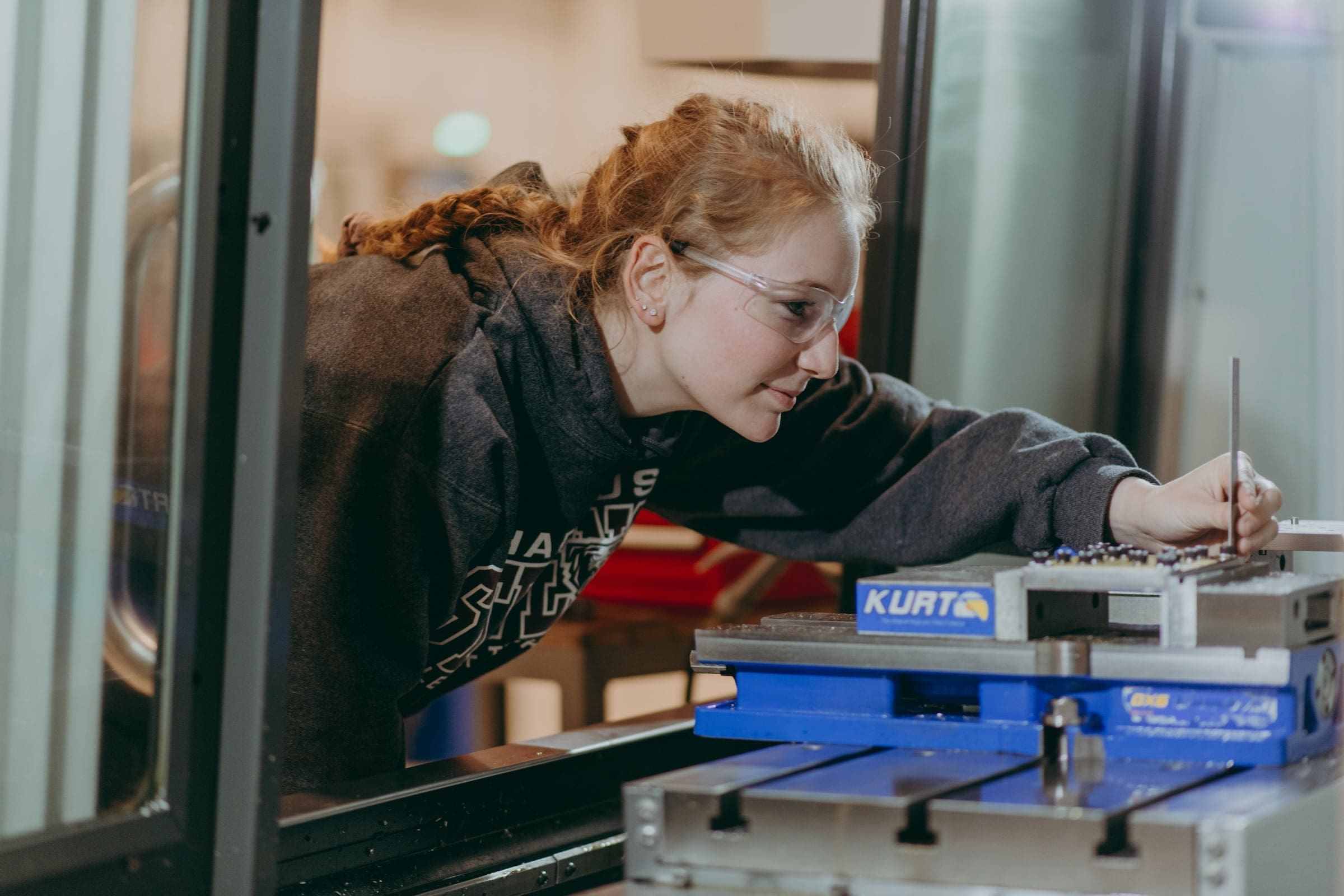
The outcomes speak for themselves
This program prepares students to enter the workforce fields of CNC, CAM, tool making, mold making, machine tool operating, quality control, industrial sales, and production or manufacturing.
83.3%
employment
$52.5K
med. salary
16.7%
cont. education
People of TSCT
Success stories
Program details
Courses
Model Schedule for Computer Integrated Machining Technology
Semester 1
- CIM 106 – Blueprint Reading and Related Math (3 credits)
- CIM 110 – Manufacturing Processes (2 credits)
- CIM 115 – Measurement Systems (2 credits)
- CIM 118 – Lathe and Vertical Milling Machine I (4 credits)
- CIM 161 – Metallurgy (2 credits)
- MATH 137 – Intermediate Algebra (or higher) (3 credits)
- CIS 105 – Drawing with AutoCad (3 credits)
Semester 2
- CIM 158 – Lathe and Vertical Milling Machine II (3 credits)
- CIM 166 – Manufacturing Processes II (3 credits)
- CIM 176 – Computer Numerical Control I (3 credits)
- CIM 222 – CAD/CAM 1 (3 credits)
- MATH 141 – Trigonometry (3 credits)
- ENG 106 – English Composition (3 credits)
Semester 3
- CIM 210 – CNC Milling (4 credits)
- CIM 211 – CNC Turning (4 credits)
- CIM 220 Geometric Dimensioning & Tolerancing (4 credits)
- CIM 272 – CAD/CAM II (3 credits)
- ENG Elective – Technical Writing or Public Speaking (3 credits)
- SCIENCE Elective – Any physics OR chem course (3 credits)
Semester 4
- CIM 228 – CAE/CAM III (3 credits)
- CIM 229 – Automation and Production Lab OR CIM 231 – Machine Tool Internship (4 credits)
- CIM 259 – Advanced CNC Milling and Automation (3 credits)
- CIM 269 – Advanced CNC Turning and Automation (3 credits)
- HUMANITIES – Elective (3 credits)
Additional General Education Requirements
HEAL 106 or HEAL 111 (1 credit)
General Studies Elective (3 credits)
Total Credits 75
Faculty
Occupational Advisory Committee
The Occupational Advisory Committee (OAC) serves as a vital link between the Program of study and industry, ensuring that the program remains aligned with current workforce needs, technological advancements, and best practices in the field. Composed of employers, educators, and other community members, the committee provides guidance, feedback, and recommendations to enhance the curriculum, instructional methods, and student learning experiences.
Purpose and Responsibilities:
- Curriculum & Industry Alignment
- Workforce Readiness
- Student & Faculty Support
- Internship & Employment Connections
- Accreditation & Program Evaluation
- Facilities & Equipment Recommendations
By fostering a strong relationship between academia and industry, the OAC helps ensure that Thaddeus Stevens College programs maintain the highest standards in CTE (career and technical education).
- Walter Boguslaw, Harold Beck and Son
- Duane Bushong, Arconic
- Leonard Dore, Flex-Cell Precision, Inc.
- Jesse Eckert, TE Connectivity
- Daniel Feeser, Johnson Controls Navy Systems
- Michael Gammache, Machined Products Company
- Jeremy Gammache, Machined Products Company
- Wes Geib, GMS
- Kim Gibson, National Novelty Brush Company
- Charissa Gift, Astro Machine Works
- Leon Good, Weaver Industries, Inc.
- Bill Guscott, PrecisionForm Inc.
- Bill Hapke, National Novelty Brush Company
- Brian Hess, Astro Machine Works
- Joyce Hostetler, Greiner Industries, Inc.
- Jennifer Jewett, Fenner, Inc.
- Lane Kintigh, Aronic
- Shane Kohr, Davies Precision Machining, Inc.
- Bryan Kurtz, Summit Steel Inc.
- Robbie Lazzari, Johnson Controls Navy Systems
- Anne Rummel, Retired
- Brian Scott, Harold Beck & Sons
- Joe Sommers, Phillips Corporation
- Andrew Wisniewski, TE Connectivity
- Amanda Wirls, New Concept Technology
- Joel Valigorsky, Retired
- Kyle Young, Thaddeus Stevens College of Technology
Essential Skills Learned
Tasks
- Write programs in the language of a machine’s controller and store programs on media, such as punch tapes, magnetic tapes, or disks.
- Determine the sequence of machine operations, and select the proper cutting tools needed to machine workpieces into the desired shapes.
- Revise programs or tapes to eliminate errors, and retest programs to check that problems have been solved.
- Analyze job orders, drawings, blueprints, specifications, printed circuit board pattern films, and design data to calculate dimensions, tool selection, machine speeds, and feed rates.
- Write instruction sheets and cutter lists for a machine’s controller to guide setup and encode numerical control tapes.
- Observe machines on trial runs or conduct computer simulations to ensure that programs and machinery will function properly and produce items that meet specifications.
- Enter computer commands to store or retrieve parts patterns, graphic displays, or programs that transfer data to other media.
- Modify existing programs to enhance efficiency.
Tools used in this occupation
- Automatic lathe or chucking machine — Computer numerically controlled CNC lathes; Screw machines
- Calipers — Digital calipers; Vernier calipers
- Coordinate measuring machines CMM — Coordinate measuring machines CMM
- Dial indicator or dial gauge — Dial indicators
- Drill press or radial drill — Computer numerical control CNC punch presses; Drill presses
Technology used in this occupation
- Computer-aided design CAD software — Autodesk AutoCAD; Dassault Systemes CATIA; Dassault Systemes SolidWork; PTC Creo Parametric
- Computer-aided manufacturing CAM software — 1CadCam Unigraphics; Autodesk PartMaker; Mastercam; Vero Software WorkNC
- Object or component oriented development software — G code; M code
- Spreadsheet software — Microsoft Excel
- Video conferencing software — FaceTime
Knowledge
- Computers and Electronics — Knowledge of circuit boards, processors, chips, electronic equipment, and computer hardware and software, including applications and programming.
- Mechanical — Knowledge of machines and tools, including their designs, uses, repair, and maintenance.
- Mathematics — Knowledge of arithmetic, algebra, geometry, calculus, statistics, and their applications.
- Production and Processing — Knowledge of raw materials, production processes, quality control, costs, and other techniques for maximizing the effective manufacture and distribution of goods.
- Design — Knowledge of design techniques, tools, and principles involved in the production of precision technical plans, blueprints, drawings, and models.
- Engineering and Technology — Knowledge of the practical application of engineering science and technology. This includes applying principles, techniques, procedures, and equipment to the design and production of various goods and services.
- English Language — Knowledge of the structure and content of the English language including the meaning and spelling of words, rules of composition, and grammar.
Skills
- Programming — Writing computer programs for various purposes.
- Monitoring — Monitoring/Assessing performance of yourself, other individuals, or organizations to make improvements or take corrective action.
- Operation Monitoring — Watching gauges, dials, or other indicators to make sure a machine is working properly.
- Active Learning — Understanding the implications of new information for both current and future problem-solving and decision-making.
- Complex Problem Solving — Identifying complex problems and reviewing related information to develop and evaluate options and implement solutions.
- Critical Thinking — Using logic and reasoning to identify the strengths and weaknesses of alternative solutions, conclusions, or approaches to problems.
- Judgment and Decision Making — Considering the relative costs and benefits of potential actions to choose the most appropriate one.
- Mathematics — Using mathematics to solve problems.
- Reading Comprehension — Understanding written sentences and paragraphs in work-related documents.
- Systems Analysis — Determining how a system should work and how changes in conditions, operations, and the environment will affect outcomes.
Abilities
- Information Ordering — The ability to arrange things or actions in a certain order or pattern according to a specific rule or set of rules (e.g., patterns of numbers, letters, words, pictures, mathematical operations).
- Near Vision — The ability to see details at close range (within a few feet of the observer).
- Perceptual Speed — The ability to quickly and accurately compare similarities and differences among sets of letters, numbers, objects, pictures, or patterns. The things to be compared may be presented at the same time or one after the other. This ability also includes comparing a presented object with a remembered object.
- Problem Sensitivity — The ability to tell when something is wrong or is likely to go wrong. It does not involve solving the problem, only recognizing there is a problem.
- Mathematical Reasoning — The ability to choose the right mathematical methods or formulas to solve a problem.
- Visualization — The ability to imagine how something will look after it is moved around or when its parts are moved or rearranged.
- Category Flexibility — The ability to generate or use different sets of rules for combining or grouping things in different ways.
- Deductive Reasoning — The ability to apply general rules to specific problems to produce answers that make sense.
Work Activities
- Interacting With Computers — Using computers and computer systems (including hardware and software) to program, write software, set up functions, enter data, or process information.
- Controlling Machines and Processes — Using either control mechanisms or direct physical activity to operate machines or processes (not including computers or vehicles).
- Getting Information — Observing, receiving, and otherwise obtaining information from all relevant sources.
- Making Decisions and Solving Problems — Analyzing information and evaluating results to choose the best solution and solve problems.
- Communicating with Supervisors, Peers, or Subordinates — Providing information to supervisors, co-workers, and subordinates by telephone, in written form, e-mail, or in person.
- Inspecting Equipment, Structures, or Material — Inspecting equipment, structures, or materials to identify the cause of errors or other problems or defects.
- Analyzing Data or Information — Identifying the underlying principles, reasons, or facts of information by breaking down information or data into separate parts.
- Drafting, Laying Out, and Specifying Technical Devices, Parts, and Equipment — Providing documentation, detailed instructions, drawings, or specifications to tell others about how devices, parts, equipment, or structures are to be fabricated, constructed, assembled, modified, maintained, or used.
Work Context
- Wear Common Protective or Safety Equipment such as Safety Shoes, Glasses, Gloves, Hearing Protection, Hard Hats, or Life Jackets — 84% responded “Every day.”
- Importance of Being Exact or Accurate — 76% responded “Extremely important.”
- Face-to-Face Discussions — 89% responded “Every day.”
- Freedom to Make Decisions — 47% responded “A lot of freedom.”
- Duration of Typical Work Week — 55% responded “More than 40 hours.”
- Indoors, Environmentally Controlled — 73% responded “Every day.”
- Sounds, Noise Levels Are Distracting or Uncomfortable — 55% responded “Every day.”
- Work With Work Group or Team — 49% responded “Extremely important.”
- Exposed to Contaminants — 59% responded “Every day.”
Interests
Interest code: RC
- Conventional — Conventional occupations frequently involve following set procedures and routines. These occupations can include working with data and details more than with ideas. Usually, there is a clear line of authority to follow.
- Investigative — Investigative occupations frequently involve working with ideas and require an extensive amount of thinking. These occupations can involve searching for facts and figuring out problems mentally.
- Realistic — Realistic occupations frequently involve work activities that include practical, hands-on problems and solutions. They often deal with plants, animals, and real-world materials like wood, tools, and machinery. Many of the occupations require working outside and do not involve a lot of paperwork or working closely with others.
Work Styles
- Attention to Detail — Job requires being careful about detail and thorough in completing work tasks.
- Independence — Job requires developing one’s own ways of doing things, guiding oneself with little or no supervision, and depending on oneself to get things done.
- Analytical Thinking — Job requires analyzing information and using logic to address work-related issues and problems.
- Dependability — Job requires being reliable, responsible, and dependable, and fulfilling obligations.
- Integrity — Job requires being honest and ethical.
- Achievement/Effort — Job requires establishing and maintaining personally challenging achievement goals and exerting effort toward mastering tasks.
- Cooperation — Job requires being pleasant with others on the job and displaying a good-natured, cooperative attitude.
- Persistence — Job requires persistence in the face of obstacles.
- Self-Control — Job requires maintaining composure, keeping emotions in check, controlling anger, and avoiding aggressive behavior, even in very difficult situations.
Work Values
- Support — Occupations that satisfy this work value offer supportive management that stands behind employees. Corresponding needs are Company Policies, Supervision: Human Relations and Supervision: Technical.
- Independence — Occupations that satisfy this work value allow employees to work on their own and make decisions. Corresponding needs are Creativity, Responsibility, and Autonomy.
- Relationships — Occupations that satisfy this work value allow employees to provide service to others and work with co-workers in a friendly non-competitive environment. Corresponding needs are Co-workers, Moral Values, and Social Service.
Performance Measures
Internal Key Performance Indicators (Sources: Internal data collections, and Post-Graduate Surveys)
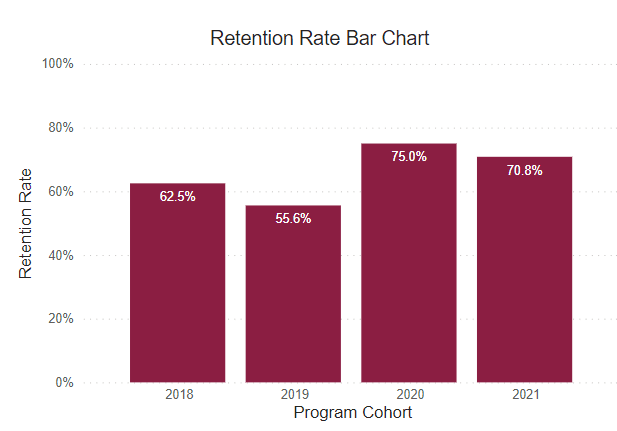
Retention Rate
This rate reflects the continuous term-to-term persistence rate for certificate programs and the fall-to-fall retention rate for associate degree programs.
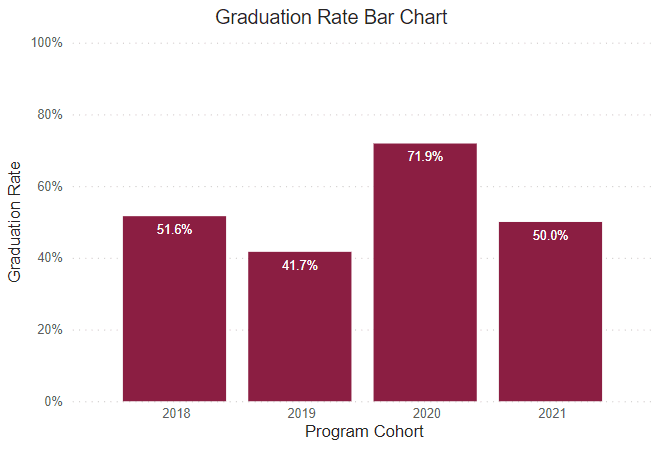
Graduation Rate
This rate reflects the number of freshmen who were officially enrolled in the fall semester and earned a certificate or degree within the expected timeframe.
Post Graduate Survey Response Rate
The post graduate survey is an annual on-line post graduate survey utilized by the college to gather vital information regarding career placement, starting salary, and level of satisfaction.
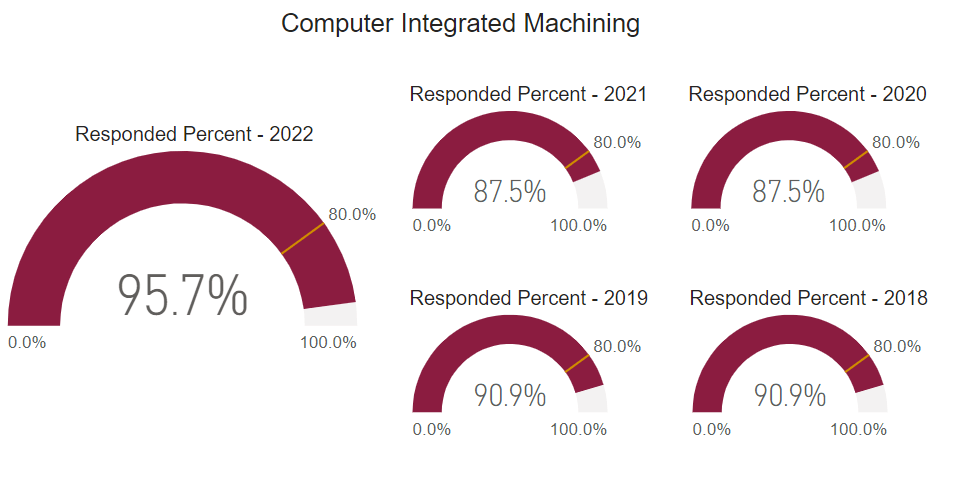
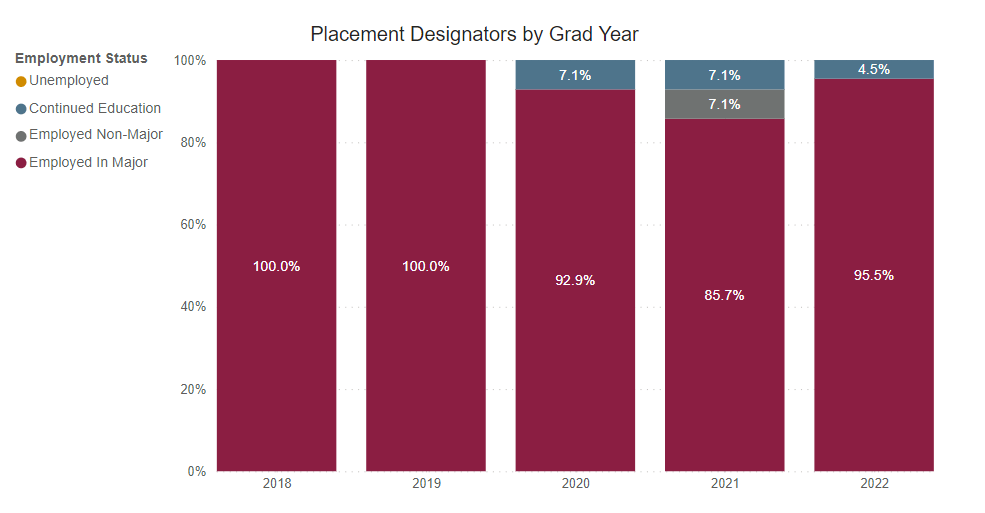
Employed Full Time Outside of Major
Percentage of graduates who reported being employed full-time outside their field of study.
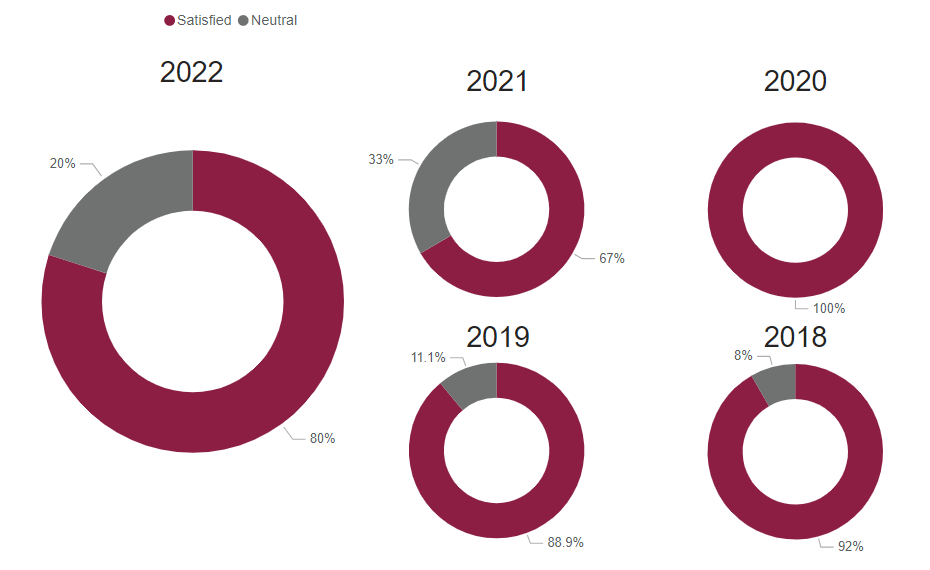
Graduate Satisfaction
This is the median graduate survey response evaluating the level of preparation for workforce entry (based on a 5-Item Likert Scale).
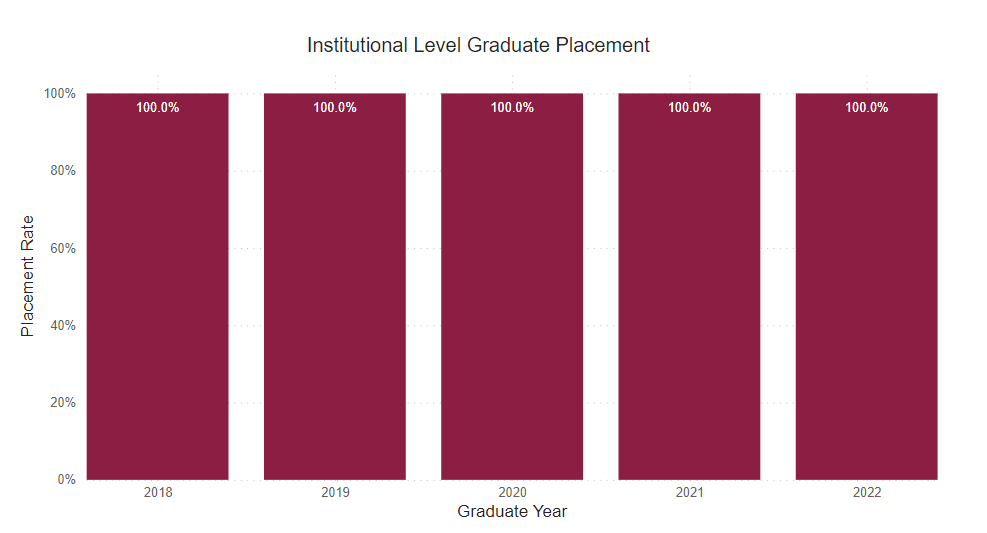
Placement Rate
This is the percent of graduate survey respondents who reported being employed or continued their education on a full-time basis.
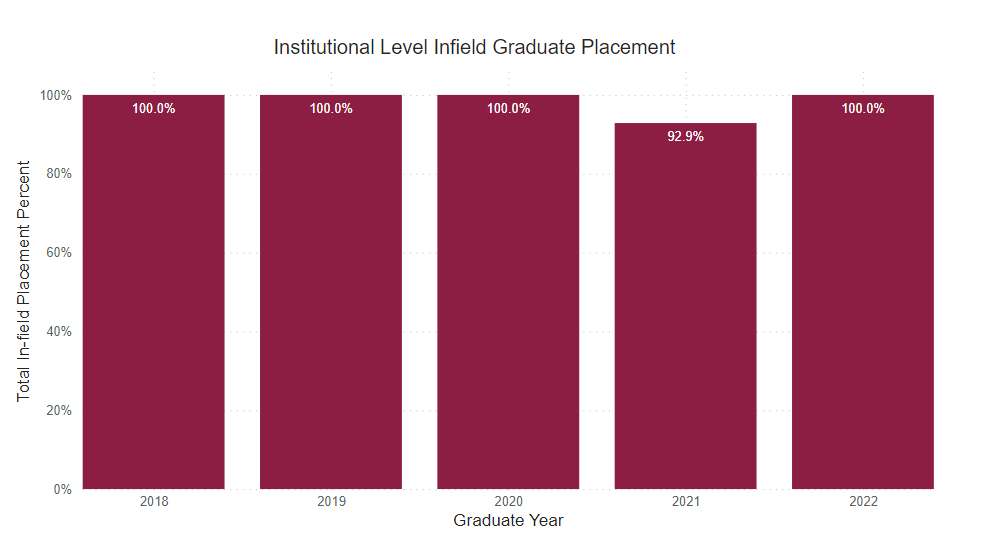
Employed Full Time Within Major
Percentage of graduates who reported being employed full-time within their field of study.
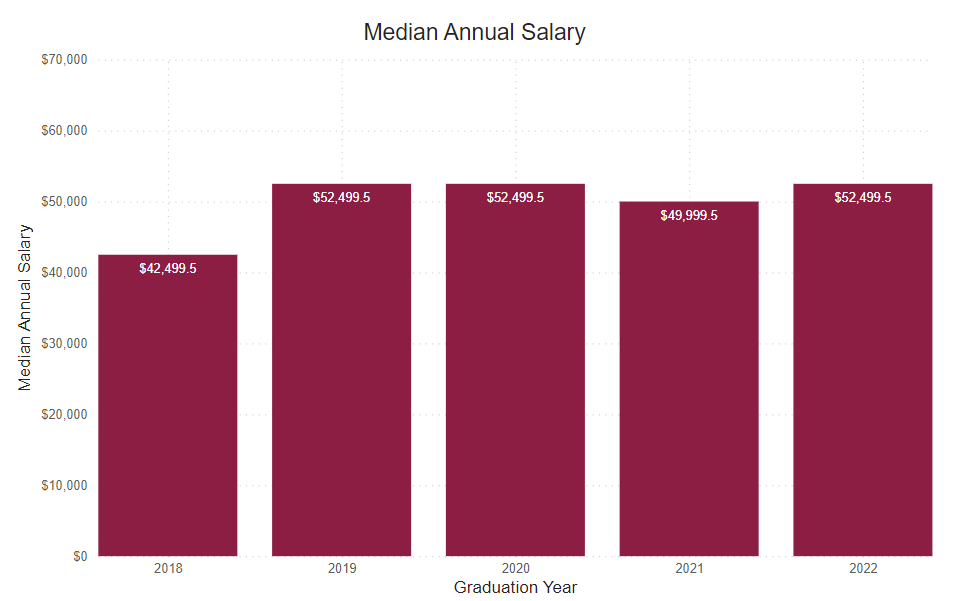
Annual Median Starting Salary
This number is based on the graduate survey response to the request to identify a starting salary from a range of options. This graph shows the median first-year annual salary. All calculations are based on the respondent’s self-reported first-year annual income.
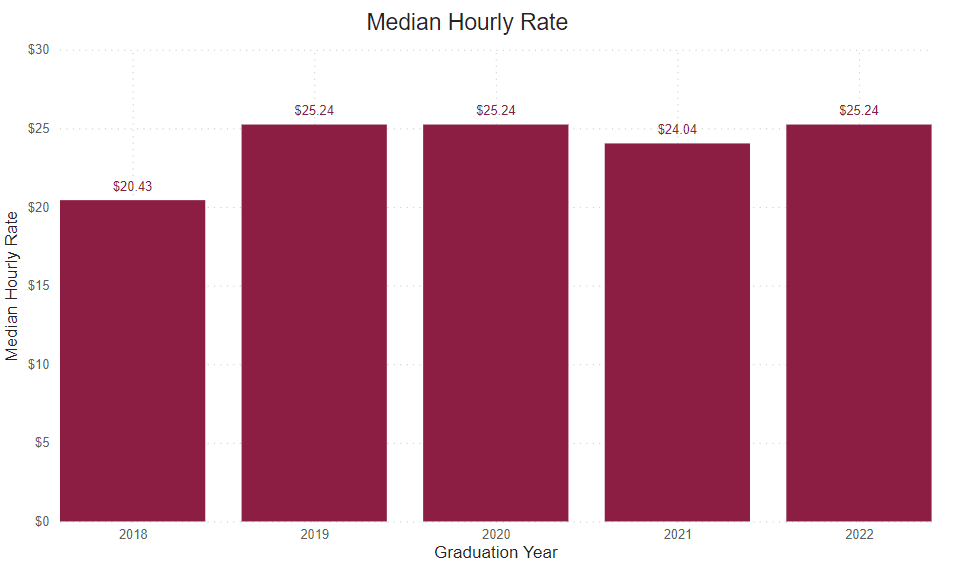
Reported Hourly Rate
This number is determined by dividing the reported median salary by the number of hours in a traditional full-time work week (40), then the number of weeks in a year (52).

Our graduates work with the industry’s best
